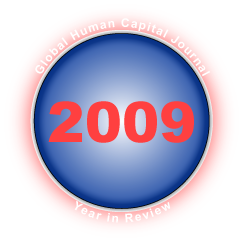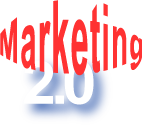Editor’s Choice of the Global Human Capital Journal—Behind the Curtain—The Best Strategy, Tactics, Case Studies and Insights of 2009
 2009 may have been many things, but boring was not among them! To do it justice, I feel like I have to dock the ship, which has been sailing on turbulent seas, frothed with spellbinding sunrises, sharks, dead winds and tempests. Volatility and surprise have certainly been the watchwords among executives I’ve collaborated with this year, and all indications are that we should look for the same in 2010. However, as dramatic as the environment is, it is only the backdrop for the real story: Enterprise social networking has found its legs and is ramping strongly. Although still tentative, social network investments are becoming pervasive due to the exploding adoption among individuals—and the latter’s impact on markets and firms. As I have been writing since 2005, digital social networking represents unprecedented disruption, opportunity and risk, and I saw many of my predictions play out in 2009.
2009 may have been many things, but boring was not among them! To do it justice, I feel like I have to dock the ship, which has been sailing on turbulent seas, frothed with spellbinding sunrises, sharks, dead winds and tempests. Volatility and surprise have certainly been the watchwords among executives I’ve collaborated with this year, and all indications are that we should look for the same in 2010. However, as dramatic as the environment is, it is only the backdrop for the real story: Enterprise social networking has found its legs and is ramping strongly. Although still tentative, social network investments are becoming pervasive due to the exploding adoption among individuals—and the latter’s impact on markets and firms. As I have been writing since 2005, digital social networking represents unprecedented disruption, opportunity and risk, and I saw many of my predictions play out in 2009.
The 2009 Year in Review gives you the chance to come up to speed rapidly or fill in the holes in your understanding. My perspective comes from intense collaboration with exceptional pioneers of enterprise-focused social networking. Many of the articles come from client work and real situations I encountered this year. I have reviewed 2009’s articles, selected the best and wrapped them in a review and analysis to help you realize where we have been, so you can better plan where you want to go in 2010.
So, throw a log on the fire, pour yourself a nice glass, and let’s dive in.
2009 Macro trends
For the first time ever, the Year in Review includes articles from GHCJ’s sister publications: the Social Network Roadmap, the Executive’s Guide to LinkedIn, the Executive’s Guide to Twitter and the Executive’s Guide to Facebook. In addition, I logged 32 speaking engagements in the U.S. and Europe this year, which brought further insights I have also shared. I have selected ten articles as MUST READ, which are clearly marked in each section. Moreover, I encourage you to share your thoughts and questions in comments.
Economy, Industry and Company
 2009 was a nail-biter for everyone on this rapidly shrinking planet. Getting through it required being grounded, amping up peripheral vision, and staying on strategy while not being afraid to question it. Meanwhile, exogenous variables invited all their cousins, adding to dynamism as well as demand for mood altering substances like bailout packages, spirits and other miscellany. The other part of the story: economic disruption became more of a constant, so it was somewhat less newsworthy, especially in light of the other categories below. The Global Human Capital Journal spawned several siblings this year, so my mix of reportage changed significantly: I spent less time on the macroeconomic and political sphere and fielded more stories on the enterprise adoption of social networking and how-to articles.
2009 was a nail-biter for everyone on this rapidly shrinking planet. Getting through it required being grounded, amping up peripheral vision, and staying on strategy while not being afraid to question it. Meanwhile, exogenous variables invited all their cousins, adding to dynamism as well as demand for mood altering substances like bailout packages, spirits and other miscellany. The other part of the story: economic disruption became more of a constant, so it was somewhat less newsworthy, especially in light of the other categories below. The Global Human Capital Journal spawned several siblings this year, so my mix of reportage changed significantly: I spent less time on the macroeconomic and political sphere and fielded more stories on the enterprise adoption of social networking and how-to articles.
Economy gurus were trying to salve wounds of all kinds, but there were so many layers of disruption that the most credible experts admitted that we were pretty much off the map. The MIT Enterprise Forum’s Economic Outlook panel of experts came to that conclusion. In a first, I live-blogged that event from my iPhone, so it’s shorter and snappier that the usual treatment. In 2009, I encountered countless CEOs, CMOs, CIOs, COOs… who, although alums of the best brands and schools, couldn’t find decent jobs unless they were willing to move to North Dakota. Thus, Economic Disruptions: How to Benefit Your Company and Career helps executives think ahead of the crowd to guide their companies and careers, so they can use this climate to their advantage. Risk and opportunity always travel together; however, the pain lately is that the amplitude of the waves is much higher than normal.
Noodle VII offers insight around the demise of several erstwhile Chicago publishing titans that are now toppling like 18th century buildings in an earthquake. The way I wrote it, you should be able to apply its lessons to other industries, too. A personal highlight of 2009 was producing and moderating the only conference track on enterprise social networking at PanIIT, a global confab of extremely smart IIT alums. President Bill Clinton was their main keynote, so I covered his preso. Startling-but-unsurprising-in-retro: he can drive more change as an ex-president!
- MUST READ—Economic Disruption: How to Benefit Your Company and Career
- MIT Enterprise Forum 2009 Economic Outlook
- Noodle VII: Tombstones and Milestones
- President Bill Clinton Asks IIT Alumni to Join in Crusade Against Inequality
Strategy and Adoption
 Economy was eclipsed by adoption and enterprise social networking this year. I watched social networking adoption intently, focusing on opportunities and threats for executives as leaders and as individuals. I went public in Q2 with the Web 2.0 Adoption Curve, 2009-2015, which predicts how the market will adopt Web 2.0 over the next five years and suggests how you can outperform the market. In Q4, I presented it at the the University of Chicago as the “Web 2.0 Investment Strategy” (video). As enterprise pioneers widely acknowledge, a key inhibitor of adoption is the lack of “ROI,” which I argue is the wrong question. Still, it’s embedded in corporate cultures everywhere, which prevents organizations from creating value—except those who have read Realizing Value from Social Networks: A Life Cycle Model ;-). It outlines four stages of relationship development and meaningful quantitative metrics for each and is one of my most powerful writings of 2009. Although it’s written from an enterprise B2B business development context, you can apply it anywhere by abstracting the ideas up a level. Alumni 2.0 outlines the enterprise opportunity to mine a brand new vein of gold: employees as company representatives will unlock a new value curve for enterprises that have the vision and courage to confront their paternalistic thinking.
Economy was eclipsed by adoption and enterprise social networking this year. I watched social networking adoption intently, focusing on opportunities and threats for executives as leaders and as individuals. I went public in Q2 with the Web 2.0 Adoption Curve, 2009-2015, which predicts how the market will adopt Web 2.0 over the next five years and suggests how you can outperform the market. In Q4, I presented it at the the University of Chicago as the “Web 2.0 Investment Strategy” (video). As enterprise pioneers widely acknowledge, a key inhibitor of adoption is the lack of “ROI,” which I argue is the wrong question. Still, it’s embedded in corporate cultures everywhere, which prevents organizations from creating value—except those who have read Realizing Value from Social Networks: A Life Cycle Model ;-). It outlines four stages of relationship development and meaningful quantitative metrics for each and is one of my most powerful writings of 2009. Although it’s written from an enterprise B2B business development context, you can apply it anywhere by abstracting the ideas up a level. Alumni 2.0 outlines the enterprise opportunity to mine a brand new vein of gold: employees as company representatives will unlock a new value curve for enterprises that have the vision and courage to confront their paternalistic thinking.
On the individual side of adoption, Job Search Techniques for Disruptive Times takes aim at outmoded Industrial Economy thinking, which prolongs executive job searches; it offers Job Search 2.0 as the remedy (“open up and share more”). Blogging and Tweeting drills down more specifically and shares this insight: “There is no one engaged in business or work who should not be blogging.” What you share and how is up to you, but I predict that interview invitations will increasingly be awarded on people’s published thoughts. The bar is going up, you have to be available when people want to access you. This is already happening.
- MUST READ—Web 2.0 Adoption Curve 2009-2015
- MUST READ—Realizing Value from Social Networks: A Life Cycle Model
- MUST READ—Alumni 2.0: Employer-Employee Realignment
- Job Search Techniques for Disruptive Times
- Blogging and Tweeting to Support Your Job Search or Fundraising
Enterprise Social Networking
 The adoption of social networking by commercial and government enterprises ramped very strongly in 2009, and 2010 will see it grow as fast as Facebook (which went from 140 million members to over 350 million, greater than the U.S. population). I published numerous case studies and conference remarks. As I’ve long predicted, the urgency to adopt Web 2.0 is proving to be as powerful as embracing the Internet was in 1998—except Web 2.0’s transformational impact will be ten times greater. Enterprises are starting to awaken to this realization, but they are taking baby steps, with a few exceptions. Executives understand that Web 2.0 has to be on their radar, and they are struggling to get their heads around it. This is one reason why the Social Network Roadmap saw so much interest: it addresses strategy and implementation and focuses on risk mitigation.
The adoption of social networking by commercial and government enterprises ramped very strongly in 2009, and 2010 will see it grow as fast as Facebook (which went from 140 million members to over 350 million, greater than the U.S. population). I published numerous case studies and conference remarks. As I’ve long predicted, the urgency to adopt Web 2.0 is proving to be as powerful as embracing the Internet was in 1998—except Web 2.0’s transformational impact will be ten times greater. Enterprises are starting to awaken to this realization, but they are taking baby steps, with a few exceptions. Executives understand that Web 2.0 has to be on their radar, and they are struggling to get their heads around it. This is one reason why the Social Network Roadmap saw so much interest: it addresses strategy and implementation and focuses on risk mitigation.
2009 saw me presenting at conferences worldwide, and on several occasions I organized panels of enterprise social networking pioneers. Of course, I used blogs to give blow-by-blow updates on planning the panels’ concepts as well as on their results. This resulted in case studies from PricewaterhouseCoopers, Dior and Imperial College London. Notably, I organized the London panel completely using LinkedIn.
In another first, I published each session I covered at the Los Angeles Social Networking Conference individually as case studies from pioneers from IBM, Sun, Wal-Mart, Dow Jones, Nokia and many others. See the Social Network Roadmap’s Conference category to get them all. Enterprise and Individual Drivers for Social Networks explains the “why” of social networks’ transformational power for executives, from individual and company viewpoints. In LinkedIn Becomes an Enterprise 2.0 Syndication Machine shows how enterprise applications should begin sourcing data from outside when appropriate, which will unlock extensive value. Unless you’re a 21st century Rip Van Winkle, you probably got tired of hearing about Twitter all year, but Thoughts on Enterprise Adoption of Twitter mashes up the concept of a “LinkedIn for Twitter” and what it might look like. Finally, Social Networks Reach Puberty is my coverage of the Miami Social Networking Conference, (numerous case studies) where I also presented on Social Networks in Healthcare as well as a workshop, “Successful Social Networking Projects in the Enterprise.”
- MUST READ—LinkedIn Becomes an Enterprise 2.0 Syndication Machine with API
- 2009 Los Angeles Social Networking Conference Highlights Enterprise Social Media Experience
- Case Study: PricewaterhouseCoopers’ Careful Yet Comprehensive Work with Social Networking
- Case Study: Dior’s Haute Couture Crowdsourcing
- Case Study: Virtual Worlds, Real Dollars
- Enterprise and Individual Drivers for Social Networks
- Thoughts on Enterprise Adoption of Twitter
- Social Networks Reach Puberty: Miami Social Networking Conference Shows Diverse Enterprise Adoption and Success
Social Networking Platform Review
 It has been proven over and over that it is easier to engage people when you go to them rather than asking them to come to you. The major platforms, LinkedIn, Facebook, Twitter, YouTube and MySpace have millions of members, and most have groups to make it easier to connect with people around specific interests. A large part of my client work is helping firms discover what venues are most appropriate and how they can engage people in the venue while being authentic, transparent and true to their business strategy. Therefore, I covered LinkedIn, Facebook and Twitter extensively in 2009. Note that many of these posts are courtesy of the Executive’s Guide to LinkedIn, The Executive’s Guide to Twitter (and Blogging) and the Social Network Roadmap (I have an in with management ,^).
It has been proven over and over that it is easier to engage people when you go to them rather than asking them to come to you. The major platforms, LinkedIn, Facebook, Twitter, YouTube and MySpace have millions of members, and most have groups to make it easier to connect with people around specific interests. A large part of my client work is helping firms discover what venues are most appropriate and how they can engage people in the venue while being authentic, transparent and true to their business strategy. Therefore, I covered LinkedIn, Facebook and Twitter extensively in 2009. Note that many of these posts are courtesy of the Executive’s Guide to LinkedIn, The Executive’s Guide to Twitter (and Blogging) and the Social Network Roadmap (I have an in with management ,^).
Strategy for LinkedIn, Twitter, Facebook outlines a high-level process for preparing a firm to engage stakeholders (customers, employees, investors…) in the major platforms. If you look carefully, you’ll recognize Social Network Roadmap Pilot. Tactics: Using LinkedIn, Facebook and Twitter is focused on how individual executives manage to use the three platforms together, how to create synergy while minimizing the time required. It is imminently doable when you stay on-task. LinkedIn and Facebook: Thumbnail Comparison analyzes opportunities to use each platform for business. It delves into similarities and differences. Reading all three will quickly make you aware of the opportunities.
Comparing Facebook and MySpace Expansion is all about Facebook’s hugely successful crowdsourcing and marketing strategy, which was simply brilliant. In case you are thinking about launching a Facebook Page, check out Just Launched: The Social Network Roadmap’s Facebook Page. I’m including several tactical posts on LinkedIn, too. Most of these came up through client work, and I deemed the issues important enough to share widely. LinkedIn: How to Leave an Employer is a step-by-step guide to managing the transition on LinkedIn. How to Evaluate LinkedIn Groups is a thumbnail guide to deciding whether to join a group or not while Five Quick Tips is for startups using LinkedIn to grow. What to Share is another post on content; it takes on a misguided Wall Street Journal article (there are more and more off-base media stories on social networking because journalists are way behind the times in most cases).
I’ll close this section with four posts on Twitter. Although it was hyped incessantly this year, Twitter is extremely transformational because its social context is mobile and 24/7. By using it, you can get to know someone far faster and at a lower cost than any other method. Twitter reigns supreme in executing the “power of small touches” strategy. If you’ve been sitting on the sidelines this year, use these four posts to get on and create much more value than your friends. Everything You Wanted to Know offers a concise background of the platform while Twitter Quick Launch Guide and Introducing show you how to get on in 30 minutes (and do it well). Value Vectors is a tool I developed for Twitter and Blogging content strategy. It makes it easy to increase the quality of your tweets.
- MUST READ—Strategy for LinkedIn, Twitter, Facebook: Where Do I Need to Be?
- Tactics: Reflections on Using LinkedIn, Facebook and Twitter
- LinkedIn and Facebook (and Twitter): Thumbnail Comparison
- Comparing Facebook and MySpace Expansion Strategy
- What to Share on Facebook and Twitter
- Everything You Wanted to Know About Twitter* But Were Afraid to Ask
- Twitter Quick Launch Guide
- Introducing Twitter (and Blogging)
- Value Vectors: The Key to Building a Quality Following
Relationships
 You may think that a section on “relationships” is a bit strange in these pages, but, as I increasingly argued in 2009, having a relationship focus is probably the most critical success factor. Try these on for size: Countering Social Networks Unique Challenges with the Relationship Life Cycle was one of my most important posts of 2009. Must-read, it features social network myths and realities! as well as how you can increase your team’s effectiveness by considering the life cycle. I offer a review of one of the most important books I read this decade: Book Review/Grooming, Gossip and the Evolution of Language deciphers why and how people form relationships, from the point of view of humans as primates! This may sound esoteric, but it’s right on target and will give you a rare understanding of what makes social networks tick (hint: it’s called social grooming).
You may think that a section on “relationships” is a bit strange in these pages, but, as I increasingly argued in 2009, having a relationship focus is probably the most critical success factor. Try these on for size: Countering Social Networks Unique Challenges with the Relationship Life Cycle was one of my most important posts of 2009. Must-read, it features social network myths and realities! as well as how you can increase your team’s effectiveness by considering the life cycle. I offer a review of one of the most important books I read this decade: Book Review/Grooming, Gossip and the Evolution of Language deciphers why and how people form relationships, from the point of view of humans as primates! This may sound esoteric, but it’s right on target and will give you a rare understanding of what makes social networks tick (hint: it’s called social grooming).
How LinkedIn Change the Economics of Cross-Border Relationships came out of a talk I gave at the Swedish-American Chamber of Commerce; it suggests how you can use LinkedIn to discover and build cross-border relationships must more quickly and inexpensively. Two articles took the New York Times and the Wall Street Journal to task for publishing lame stories; I point out their faulty arguments and show how you can outperform your competitors. Twitter: Disruptive Innovation of the Decade deciphers Twitter’s uniqueness and suggests how it ruffled feathers at Google and Facebook in 2009. Finally, Networks: Thoughts on Quality vs. Quantity is a short post that is relevant to any social network.
- MUST READ—Countering Social Networks’ Unique Challenges with the Relationship Life Cycle
- MUST READ—Book Review/Grooming, Gossip, and the Evolution of Language
- How LinkedIn Changes the Economics of Cross-Border Relationships
- Debunking Uninformed Media Coverage of Social Networks
- Wall Street Journal Claims Facebook Can’t Give You Relationships
- Twitter: Disruptive Innovation of the Decade
- Networks: Thoughts on Quality vs. Quantity
Marketing 2.0 and Customer Experience
 As I have been writing for years, value is rapidly migrating from products to (customer) experience, which will disrupt the entire marketing function at most companies. Up to now, it’s been the slow boil, but I saw increasing examples in 2009. Post-Product Marketing and Engagement confronts this change straight on, and suggests steps you can take to get ahead of your favorite competitors. Increasing Customer Transparency was another post that came up from a CMO group: Isn’t it risky to interact with customers online, where competitors can steal them? This is legacy thinking; move to more transparency as fast as you can. Firms that try to hide customers open themselves to more risk, not less. The Dirty Dozen is a short list of snafus that companies too often find themselves in. How many do you know? Strangle Me, with tongue firmly in cheek, takes aim at Apple’s ineptitude with “Mobile Me,” which won Apple the only Web 0.2 Citation I conferred in 2009. Update: Website Design 2.0 takes aim at conventional wisdom about Websites’ role and design. Too many execs want to “sex up their Websites with social media.” Dangerous thinking because Web 2.0 enables everyone to talk, so you will get better ROI by having others talk and having conversations off your site. Advertising on Twitter? is a quick piece on the emerging trend of “sponsored tweets” in which marketers pay celebs to tweet for the brand.
As I have been writing for years, value is rapidly migrating from products to (customer) experience, which will disrupt the entire marketing function at most companies. Up to now, it’s been the slow boil, but I saw increasing examples in 2009. Post-Product Marketing and Engagement confronts this change straight on, and suggests steps you can take to get ahead of your favorite competitors. Increasing Customer Transparency was another post that came up from a CMO group: Isn’t it risky to interact with customers online, where competitors can steal them? This is legacy thinking; move to more transparency as fast as you can. Firms that try to hide customers open themselves to more risk, not less. The Dirty Dozen is a short list of snafus that companies too often find themselves in. How many do you know? Strangle Me, with tongue firmly in cheek, takes aim at Apple’s ineptitude with “Mobile Me,” which won Apple the only Web 0.2 Citation I conferred in 2009. Update: Website Design 2.0 takes aim at conventional wisdom about Websites’ role and design. Too many execs want to “sex up their Websites with social media.” Dangerous thinking because Web 2.0 enables everyone to talk, so you will get better ROI by having others talk and having conversations off your site. Advertising on Twitter? is a quick piece on the emerging trend of “sponsored tweets” in which marketers pay celebs to tweet for the brand.
- MUST READ—Post-Product Marketing and Engagement
- Increasing Customer Transparency: Real Threat or Paper Tiger for Marketers?
- The Dirty Dozen: Are You Experiencing Symptoms of Web 2.0 Misalignment?
- Strangle Me: Apple Awarded Web 0.2 Citation for Delivering Painful Paroxysm of Yechsperience
- Update: Website Design 2.0
- Advertising on Twitter?
Technology
 Web 2.0’s emphasis on people has the technology continuing to recede into the background, but here are some posts that merit your attention. Web 2.0 Single Sign-on points out that companies must strongly consider syndicating in content from the outside, and LinkedIn just released their LinkedIn Platform. Catch up with this trend to increase your relevance and productivity while reducing costs. Web 2.0 Pitfall #1 reprises a danger I saw constantly in 2009, assuming that your company needs a blog, a Facebook Page, a wiki… These are technology choices and are sure to express you to the land of disappointment because they don’t consider stakeholders and what they want. BTW, don’t ask stakeholders if they want a wiki or a blog, they don’t know. You need to delve into their workstreams, goals, culture, etc. It doesn’t take long, but it pays big dividends.
Web 2.0’s emphasis on people has the technology continuing to recede into the background, but here are some posts that merit your attention. Web 2.0 Single Sign-on points out that companies must strongly consider syndicating in content from the outside, and LinkedIn just released their LinkedIn Platform. Catch up with this trend to increase your relevance and productivity while reducing costs. Web 2.0 Pitfall #1 reprises a danger I saw constantly in 2009, assuming that your company needs a blog, a Facebook Page, a wiki… These are technology choices and are sure to express you to the land of disappointment because they don’t consider stakeholders and what they want. BTW, don’t ask stakeholders if they want a wiki or a blog, they don’t know. You need to delve into their workstreams, goals, culture, etc. It doesn’t take long, but it pays big dividends.
Finally, I migrated the Global Human Capital Journal from Serendipity to WordPress, and I offer a couple posts about that experience. I also got hacked this year, so I show how to mitigate insertion attacks. Never a dull moment!
- MUST READ—Web 2.0 Single Sign-on Update: Federating Friends with Facebook Connect and Google Friendconnect
- Web 2.0 Pitfall #1: The “Solutions Centric” Approach to Social Venues
Developments at the Global Human Capital Journal
If you made it this far, I hope you can see that 2009 was an amazing year at the Global Human Capital Journal. If you would like a wider retrospective, check out Decade in Review 200-2009. Here are some other related developments:
|
By the way, we don’t use your email for anything nefarious, and you directly control the contact information we have. |

Do you have the slide deck from the talk you “presented on Social Networks in Healthcare” in Miami? Or is the talk recorded somewhere?
Blessings,
Jim Bob
Hi Jim Bob, thanks for finding online, and please reach out with additional questions. Have a lot more content, too! Are you going to be in Miami later this month?
[…] on which I’ll build for my 2010 recommendations. By the way, this follows Year in Review—2009/Social Networking Gains Legs on Heavy Seas and Decade in Review 2000–2009/The Rise of Web 2.0, the New Pervasive Human […]
[…] Year in Review—2009 is a more micro trend analysis of 2009. […]